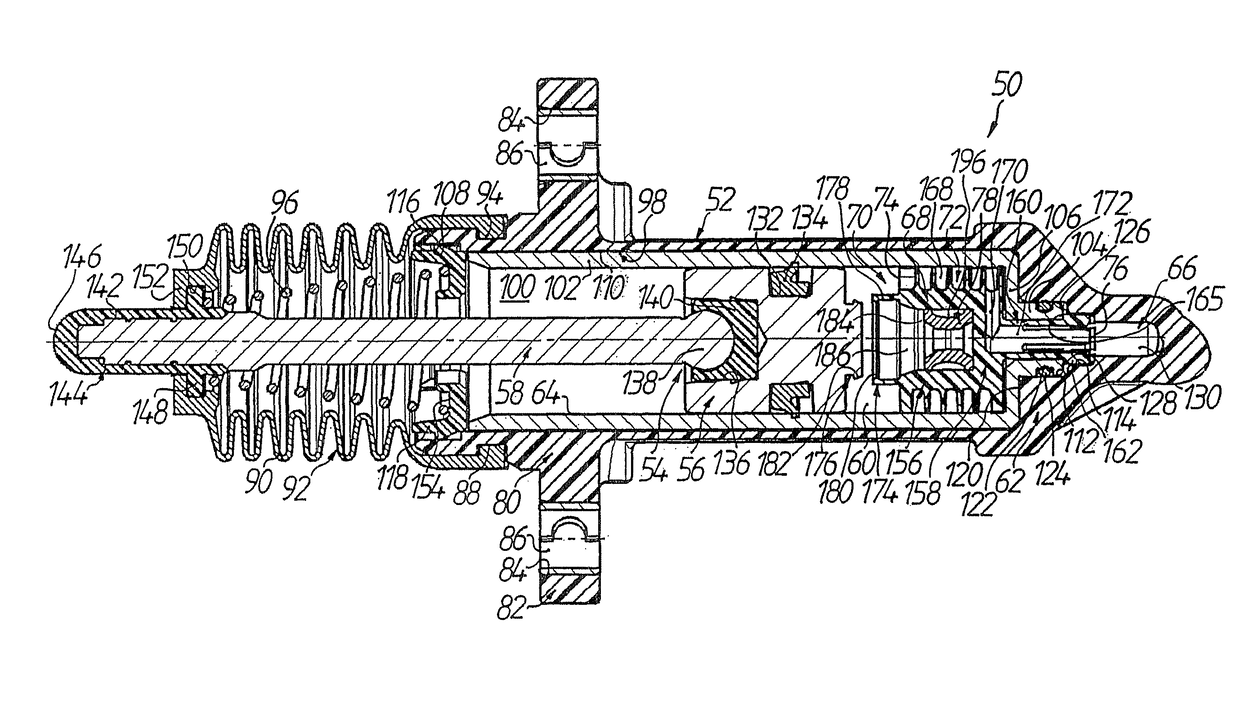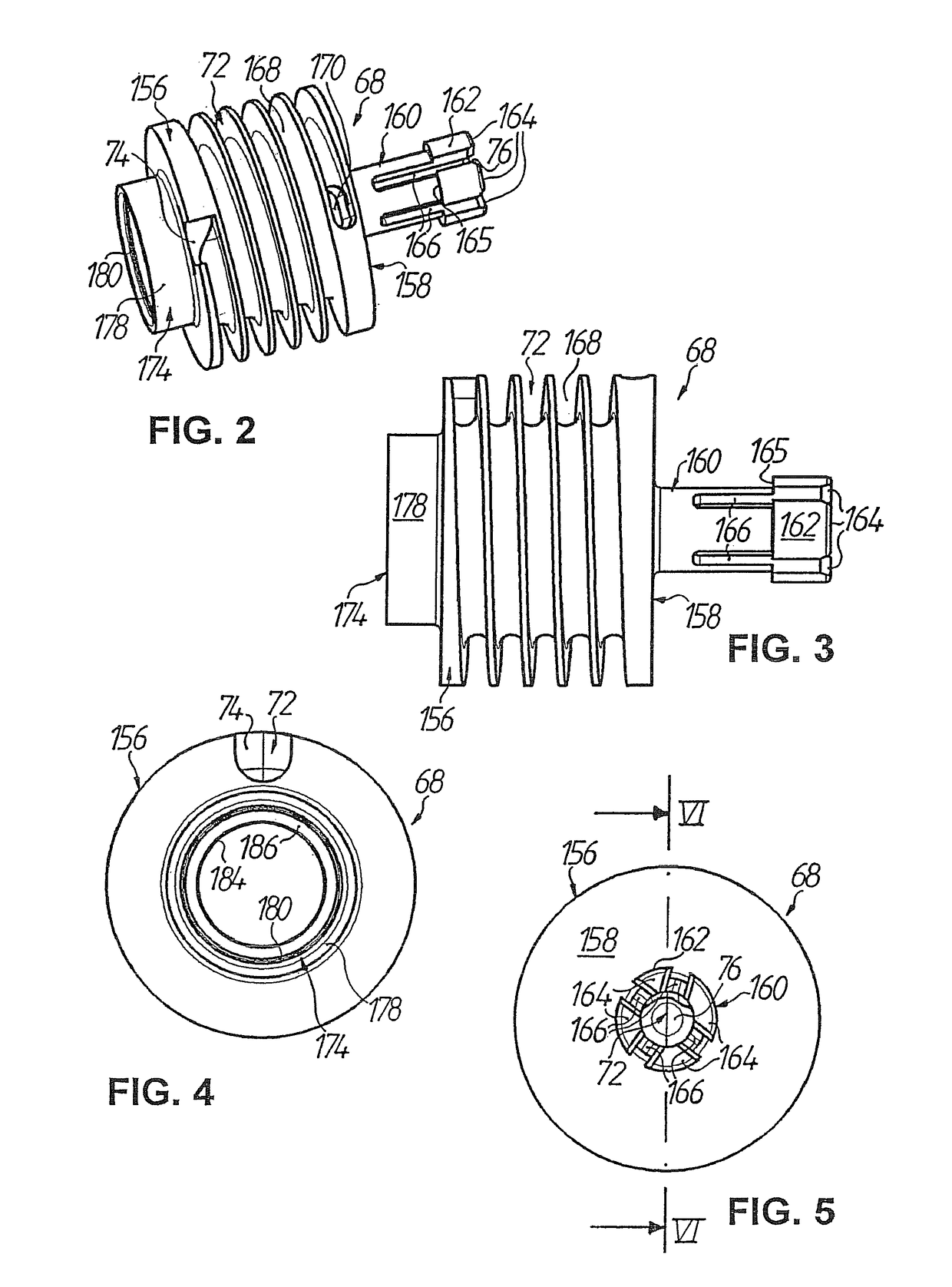Device for reducing pressure pulsations
a technology of pulsation and device, which is applied in the direction of fluid gearings, pipe elements, couplings, etc., can solve the problems of particularly short and compact construction of devices, and achieve the effect of favorable maintenan
- Summary
- Abstract
- Description
- Claims
- Application Information
AI Technical Summary
Benefits of technology
Problems solved by technology
Method used
Image
Examples
first embodiment
[0077]As already mentioned in the introduction, the thus-constructed device 70′ for reducing pressure pulsations can be arranged largely freely in the hydraulic line between slave cylinder and master cylinder, for example between a hose section, which is at the slave cylinder side, and a pipe section which is at the master cylinder side, of the hydraulic line. The function or manner of effect of the device 70′ in this regard corresponds with that of the device 70 according to the
[0078]In the case of the third embodiment illustrated in FIGS. 13 to 15 firstly the slave connection 202″ and the master connection 204″ of the two-part housing 200″ are constructed differently from the case of the second embodiment, namely mutually reversed so that the slave connection 202″ is formed as receiving part whilst the slave connection 204″ is constructed as plug part. In this regard the recess 222″ of the slave connection 202″ is in fluid connection with the pressure medium chamber 208″ via a pas...
third embodiment
[0083]Tests were also carried out with respect to the third embodiment, the result of which is illustrated in FIG. 16 by way of example. The actual performance of the test corresponded with that which was already described further above with reference to FIG. 10. However, in the present case use was made of a slave cylinder with an effective piston effective diameter of 19.05 mm and a master cylinder with an effective piston effective diameter of 15.87 mm, which—analogously to FIG. 23—were hydraulically connected together by way of, starting from the slave cylinder, (a) a metallic clutch pipe section (inner diameter: approx. 4.75 mm; wall thickness: approx. 0.7 mm; length: approx. 300 mm), (b) an elastomeric clutch hose section (inner diameter: approx. 6 mm; outer diameter: approx. 12 mm; length: approx. 250 mm, one fabric layer) and (c) a metallic clutch pipe section (inner diameter: approx. 6 mm, wall thickness: approx. 0.7 mm; length: approx. 400 mm) of an existing pressure line ...
second embodiment
[0098]The connecting member 306 itself has, analogously to the second embodiment described in the foregoing with reference to, in particular, FIG. 12, a master connection 204 with receiving geometry known per se, having the recess 222 ending at the opening 76 of the channel 72 at the master cylinder side, the securing element 224 and the insertion slot 226 for that purpose. In addition, the plug end or plug section 304 is provided with an annular groove for reception of an O-ring 318 which seals relative to the second receiving section 302 of the stepped bore 294.
[0099]The insert member 68 bearing against the annular shoulder 320 formed between the first receiving section 298 and the second receiving section 302 of the stepped bore 294 similarly has at the outer circumference of the projection 300 an annular groove 322 (cf. FIG. 21) in which a further O-ring 324 is received, which seals relative to the first receiving section 298 of the stepped bore 294. Finally, the insert member 6...
PUM
 Login to View More
Login to View More Abstract
Description
Claims
Application Information
 Login to View More
Login to View More - R&D Engineer
- R&D Manager
- IP Professional
- Industry Leading Data Capabilities
- Powerful AI technology
- Patent DNA Extraction
Browse by: Latest US Patents, China's latest patents, Technical Efficacy Thesaurus, Application Domain, Technology Topic, Popular Technical Reports.
© 2024 PatSnap. All rights reserved.Legal|Privacy policy|Modern Slavery Act Transparency Statement|Sitemap|About US| Contact US: help@patsnap.com










